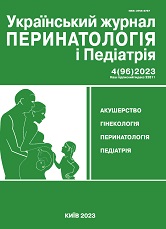Erythema infectiosum and Raynaud’s phenomenon in a child after a coronavirus disease: description of a clinical case
DOI:
https://doi.org/10.15574/PP.2023.96.145Keywords:
infectious erythema, Raynaud's phenomenon, coronavirus diseaseAbstract
Purpose - to analyze practice cases with an atypical course associated with comorbid pathology; to acquaint pediatricians and family physicians with the diagnostic search algorithm.
The article summarizes literature data, and describes a clinical case of erythema infectiousum in combination with Raynaud's phenomenon, which occurred in a 9-year-old child І. with coronavirus disease in anamnesis. It was established that the nature of the pathological changes: periodic hyperemia of the cheeks and auricles, “slapped cheeks”, and, at the same time, palleness of the nasolabial triangle, a pronounced change in color, marbling of the skin on the limbs and on the buttocks, with a lacy pattern of vessels, which are provoked by exposure to cold air or psycho-emotional excitement, clearly indicate both the manifestations of parvovirus infection, and the Raynaud's phenomenon mentioned above. On the other hand, post-covid syndrome is also often accompanied by non-specific changes in the skin and its derivatives (up to 20.4% of cases) in the form of urticaria, erythema, and frostbite. In the same group of patients, there are maculopapular rashes and livedo reticularis, those could be Conclusions. During the pandemic of coronavirus infection, the issues of comorbid pathological conditions in pediatrics, which have a blurred clinical picture, an atypical course, common links of pathogenesis, in particular microcirculation disorders, and require an interdisciplinary approach to the management of these diseases, rehabilitation measures, are becoming more and more relevant.
interpreted both as a manifestation of systemic vasculitis, and as independent disease. Thus, the patient was diagnosed with infectious erythema caused by parvovirus B19 in combination with Raynaud's phenomenon, probably caused by a history of coronavirus disease. The multicomponent nature of the patient's symptoms is highlighted, and the diagnostic search algorithm is shown.
The study was conducted in accordance with the principles of the Declaration of Helsinki. An informed parental consent was obtained for the study in children.
No conflict of interests was declared by the authors.
References
Algwaiz G, Alharbi A, Alsehaim K et al. (2023, May 23). Hematologic Manifestations of Parvovirus B19 Infection. Hematol Oncol Stem Cell Ther. 16(4): 316-322. https://doi.org/10.56875/2589-0646.1031; PMid:37363985
Drago F, Ciccarese G, Rebora A, Muzic SI, Parodi A. (2020, Oct). SARS-CoV-2 infection: the same virus can cause different cutaneous manifestations. Br J Dermatol. 183(4): 788. Epub 2020 Jul 13. https://doi.org/10.1111/bjd.19311; PMid:32533844 PMCid:PMC7323380
Filippatos F, Tatsi EB, Michos A. (2022, Aug 2). Post-COVID-19 syndrome in children (Review). Exp Ther Med. 24(4): 609. https://doi.org/10.3892/etm.2022.11547; PMid:36160884 PMCid:PMC9468832
Kostolansky S, Waymack JR. (2023, Jul 31). Erythema Infectiosum. In: StatPearls [Internet]. Treasure Island (FL): StatPearls Publishing. PMID: 30020681.
Leung AKC, Lam JM, Barankin B, Leong KF, Hon KL. (2023, Apr 28). Erythema Infectiosum: A Narrative Review. Curr. Pediatr. Rev. Epub ahead of print. https://doi.org/10.2174/1573396320666230428104619; PMid:37132144
Musa R, Qurie A. Raynaud Disease. (2023, Aug 8). In: StatPearls [Internet]. Treasure Island (FL): StatPearls Publishing; Jan. PMID: 29763008.
Quddusi FI, Youssef MJ, Davis DMR. (2021). Dermatologic Manifestations of Systemic Diseases in Childhood. Pediatric Review. 42 (12): 655-671. https://doi.org/10.1542/pir.2020-000679; PMid:34850179
Smatti MK, Cyprian FS, Nasrallah GK et al. (2019). Viruses and autoimmunity: a review on the potential interaction and molecular mechanisms. Viruses. 11: 762. https://doi.org/10.3390/v11080762; PMid:31430946 PMCid:PMC6723519
Takashita E, Kawakami C, Momoki T. (2021, Jul). Increased risk of rhinovirus infection in children during the coronavirus disease-19 pandemic. Influenza Other Respir Viruses. 15(4): 488-494. Epub 2021 Mar 14. https://doi.org/10.1111/irv.12854; PMid:33715290 PMCid:PMC8189209
Downloads
Published
Issue
Section
License
Copyright (c) 2023 Ukrainian Journal of Perinatology and Pediatrics

This work is licensed under a Creative Commons Attribution-NonCommercial 4.0 International License.
The policy of the Journal “Ukrainian Journal of Perinatology and Pediatrics” is compatible with the vast majority of funders' of open access and self-archiving policies. The journal provides immediate open access route being convinced that everyone – not only scientists - can benefit from research results, and publishes articles exclusively under open access distribution, with a Creative Commons Attribution-Noncommercial 4.0 international license(СС BY-NC).
Authors transfer the copyright to the Journal “MODERN PEDIATRICS. UKRAINE” when the manuscript is accepted for publication. Authors declare that this manuscript has not been published nor is under simultaneous consideration for publication elsewhere. After publication, the articles become freely available on-line to the public.
Readers have the right to use, distribute, and reproduce articles in any medium, provided the articles and the journal are properly cited.
The use of published materials for commercial purposes is strongly prohibited.

